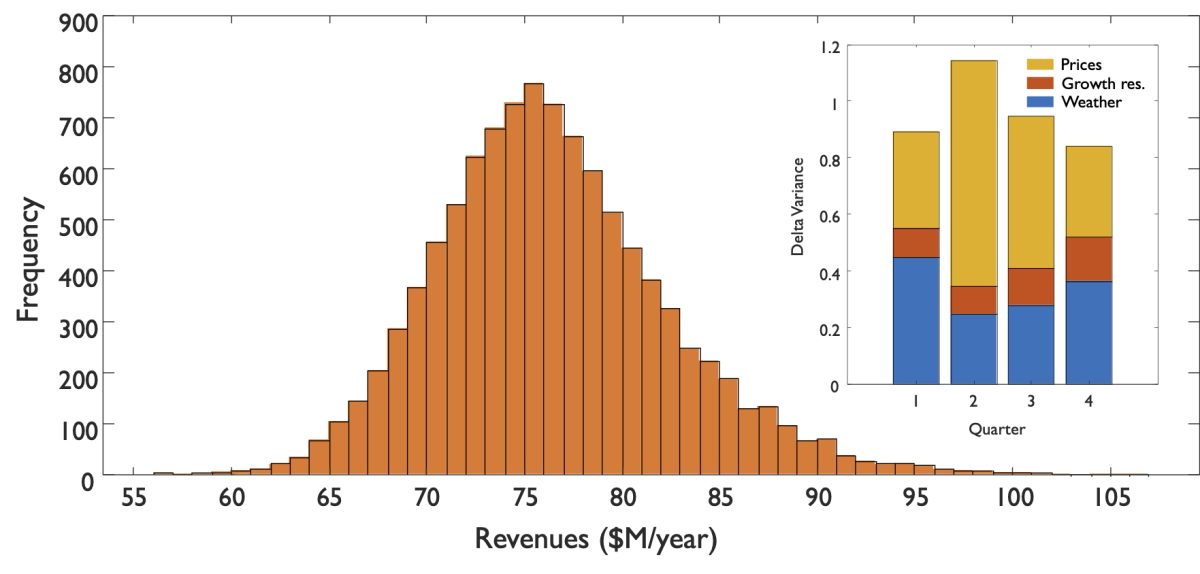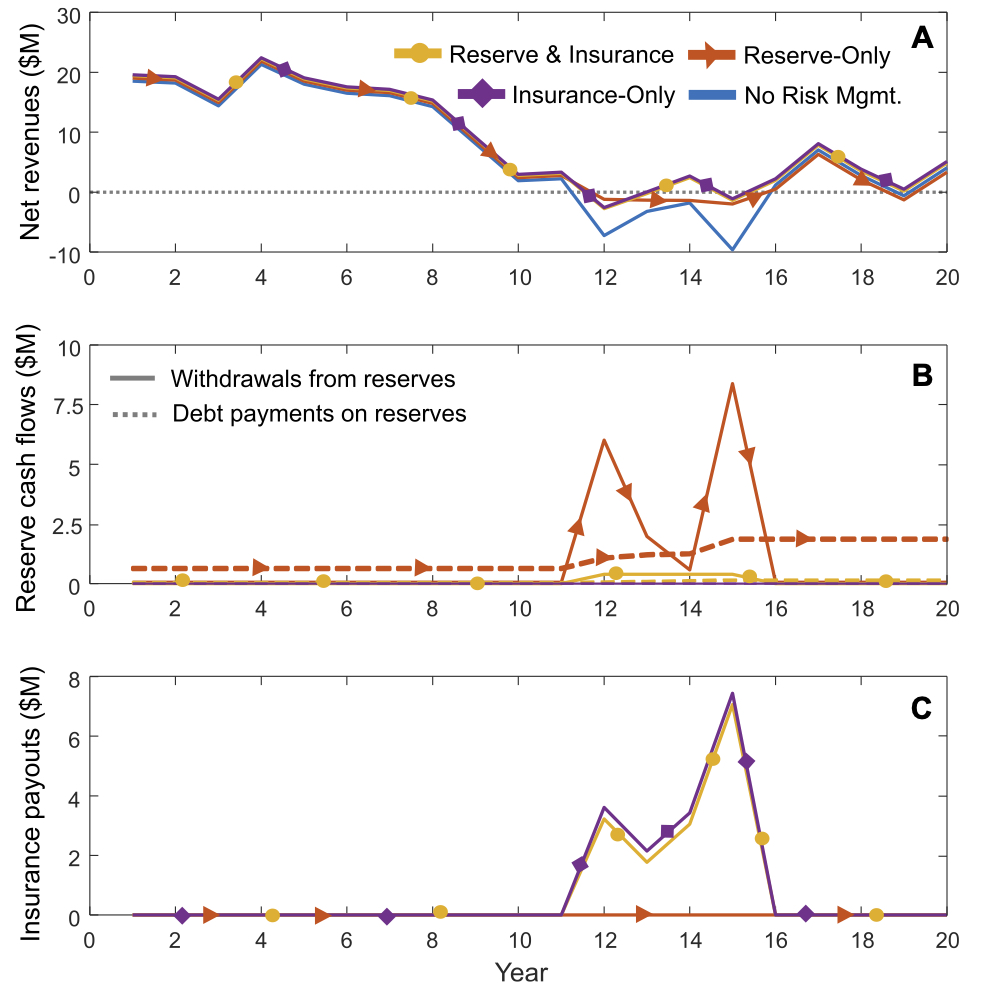Center on Financial Risk in Environmental Systems: Biofuels
Biofuels
Project 1 Title:
Characterizing Weather-related Biophysical and Financial Risk in Algal Biofuel Production
Summary:
Algal biofuels are a renewable liquid fuel with advantages over crop-based biofuels, including higher yield per acre, the ability to recycle production inputs (e.g., water, nutrients), and the option to create valuable co-products (e.g., Omega-3 oils). Previous analyses suggest that algal biofuels could become cost-competitive if technological improvements are achieved. Most previous research, however, does not consider the impact of seasonal and year-to-year uncertainty in weather factors, such as solar irradiance and temperature, on biomass productivity, and those that do are based on limited meteorological records. This research seeks to quantify weather-related financial risks to algal biofuel facilities and compare it with other financial risks, including variable market prices for biofuel.

Variability in algal biorefinery revenues (primary figure) and the fraction of revenue variance attributable to market prices, weather, and unaccounted for growth factors (inset figure).
Description:
This study explores the influence of weather uncertainty on algal biomass growth and bio- refinery revenues as well as impacts from market price uncertainty. The performance of a hypothetical algal biorefinery in Vero Beach, Florida is explored by combining stochastic weather generation, biophysical growth modelling, stochastic market price generation, and techno-economic analysis. Results show coefficient of variation values of 8–15% in seasonal revenues for an algae producer. In sensitivity analyses, both weather and price fluctuations are found to be significant sources of financial risk. This is the first probabilistic quantification of weather-related production impacts for algae producers, which is relevant given global growth in the algae industry and industry concerns over weather-related financial losses, a concern that has given rise to algae becoming newly eligible for crop insurance in the US 2018 Farm Bill.
Related Publications:
[superscripts denoting graduate students (M = masters; D = doctoral) and Post-doctoral Researchers (P) or Researchers (R)) working in CoFiRES]
Kleiman, R.M, Characklis, G. W., Kern, J. D. and R. Gerlach (2021). “Characterizing Weather-related Biophysical and Financial Risk in Algal Biofuel Production,” Applied Energy, 294, 116960, https://doi.org/10.1016/j.apenergy.2021.116960
Project 2 Title:
Managing Weather- and Market Price-related Financial Risks in Algal Biofuel Production
Summary:
Large-scale algae production has garnered interest due to its potential as a biofuel feedstock. Previous research assessing the profitability of algae products has been mostly based on values averaged over time, but algae production and resulting financial returns exhibit significant variability due to fluctuations in weather and the selling prices for algae-based products. In other sectors, producers often reduce weather- and market price-related financial risk with financial instruments such as insurance, but little research has been performed on the design of insurance products to protect algae producers.

A single simulated 20-year planning horizon that describes (A) net revenues, (B) reserve fund cash flows used to manage financial risk, and (C) insurance payouts from a weather-index based contract
Description:
This study develops a novel index-based insurance contract that pays-out during unfavorable weather and market conditions, then explores the instrument’s effectiveness, in combination with a cash reserve, of reducing revenue variability for an algae producer. Results indicate that a biophysically based index-insurance product tailored to the specific financial risks in algae pro- duction can reduce variability in net revenues and can do so at a lower cost than relying solely on cash reserves, the most common financial risk management tool. Assessing the performance of index-insurance in algae production is particularly timely given the passage of the 2018 Farm Bill, which opens opportunities for the USDA to provide crop insurance to algae producers.
Related Publications:
[superscripts denoting graduate students (M = masters; D = doctoral) and Post-doctoral Researchers (P) or Researchers (R)) working in CoFiRES]
Kleiman, R.M, Characklis, G. W. and J. D. Kern (2022). “Managing Weather- and Market Price-related Financial Risks in Algal Biofuel Production,” Renewable Energy, 200, 111-124, https://doi.org/10.1016/j.renene.2022.09.104
Collaborators:
Dr. Robin Gerlach, Montana State
Dr. Sridhar Viamajala, Toledo
Other Publications from related projects:
[superscripts denoting graduate students (M = masters; D = doctoral) and Post-doctoral Researchers (P) or Researchers (R)) working in CoFiRES]
Kern, J. D.R, Gorelick, D. E.D, Characklis, G. W. and C. M. Macklin (2018). “Multi-Objective Optimal Siting of Algal Biofuel Production with Municipal Wastewater Treatment in Watersheds with Nutrient Trading Markets,” Journal of Water Resources Planning and Management, doi.org/10.1061/(ASCE)WR.1943-5452.0001018.
Kern, J. D.R, Hise, A. M.M, Characklis, G. W., Gerlach, R., Viamajala, S. and R. D. Gardner (2016). “Using Life-Cycle Assessment and Techno-Economic Analysis in a Real Options Framework to Inform the Design of Algal Biofuel Production Facilities,” Bioresource Technology, 225, doi.org/10.1016/j.biortech.2016.11.116.
Hise, A. M.M, Characklis, G. W., Kern, J. D.P, Gerlach, R., Viamajala, S., Gardner, R. D. and A. Vadlamani (2016). “Evaluating the Relative Impacts of Operational and Financial Factors on the Competitiveness of an Algal Biofuel Production Facility,” Bioresource Technology, 220, pp. 271-281. doi:10.1016/j.biortech.2016.08.050.
Fields, M. W., Hise, A.M, Lohman, E. J., Bell, T., Gardner, R. D., Corredor, L., Moll, K., Peyton, B. M., Characklis, G. W. and R. Gerlach (2014). “Sources and Re-sources: Importance of nutrients, resource allocation and ecology in microalgal cultivation for lipid accumulation,” Applied Microbiology and Biotechnology, 98, pp. 4805-4816, doi:10.1007/s00253-014-5694-7.
Funding Support:
Department of Energy, award nos. DE-EE0005993, DE‐EE0008247 and DE-EE0009273
